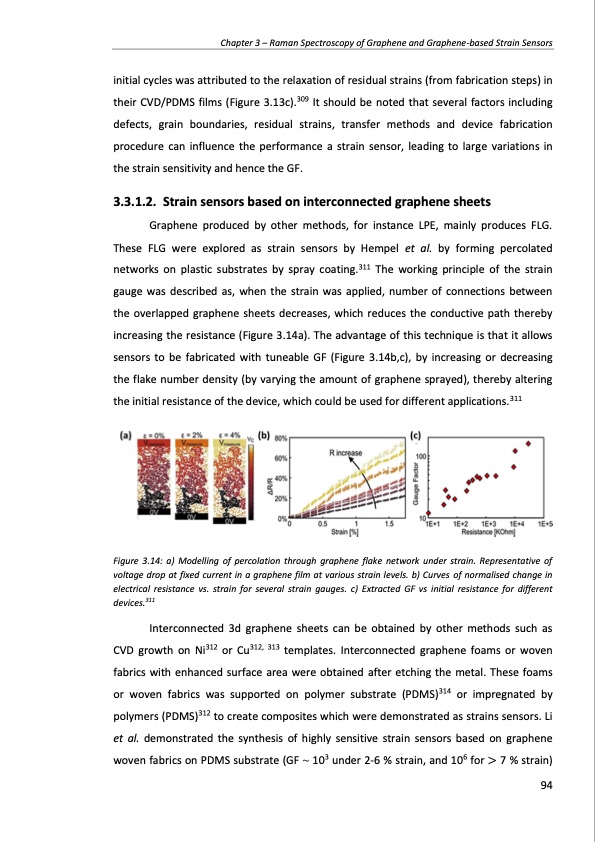PDF Publication Title:
Text from PDF Page: 094
Chapter 3 – Raman Spectroscopy of Graphene and Graphene-based Strain Sensors initial cycles was attributed to the relaxation of residual strains (from fabrication steps) in their CVD/PDMS films (Figure 3.13c).309 It should be noted that several factors including defects, grain boundaries, residual strains, transfer methods and device fabrication procedure can influence the performance a strain sensor, leading to large variations in the strain sensitivity and hence the GF. 3.3.1.2. Strain sensors based on interconnected graphene sheets Graphene produced by other methods, for instance LPE, mainly produces FLG. These FLG were explored as strain sensors by Hempel et al. by forming percolated networks on plastic substrates by spray coating.311 The working principle of the strain gauge was described as, when the strain was applied, number of connections between the overlapped graphene sheets decreases, which reduces the conductive path thereby increasing the resistance (Figure 3.14a). The advantage of this technique is that it allows sensors to be fabricated with tuneable GF (Figure 3.14b,c), by increasing or decreasing the flake number density (by varying the amount of graphene sprayed), thereby altering the initial resistance of the device, which could be used for different applications.311 Figure 3.14: a) Modelling of percolation through graphene flake network under strain. Representative of voltage drop at fixed current in a graphene film at various strain levels. b) Curves of normalised change in electrical resistance vs. strain for several strain gauges. c) Extracted GF vs initial resistance for different devices.311 Interconnected 3d graphene sheets can be obtained by other methods such as CVD growth on Ni312 or Cu312, 313 templates. Interconnected graphene foams or woven fabrics with enhanced surface area were obtained after etching the metal. These foams or woven fabrics was supported on polymer substrate (PDMS)314 or impregnated by polymers (PDMS)312 to create composites which were demonstrated as strains sensors. Li et al. demonstrated the synthesis of highly sensitive strain sensors based on graphene woven fabrics on PDMS substrate (GF ~ 103 under 2-6 % strain, and 106 for > 7 % strain) 94PDF Image | PRODUCTION AND APPLICATIONS OF GRAPHENE AND ITS COMPOSITES

PDF Search Title:
PRODUCTION AND APPLICATIONS OF GRAPHENE AND ITS COMPOSITESOriginal File Name Searched:
graphene-production-applications.PDFDIY PDF Search: Google It | Yahoo | Bing
Salgenx Redox Flow Battery Technology: Power up your energy storage game with Salgenx Salt Water Battery. With its advanced technology, the flow battery provides reliable, scalable, and sustainable energy storage for utility-scale projects. Upgrade to a Salgenx flow battery today and take control of your energy future.
CONTACT TEL: 608-238-6001 Email: greg@infinityturbine.com (Standard Web Page)